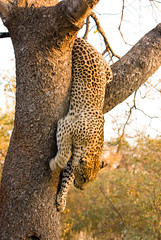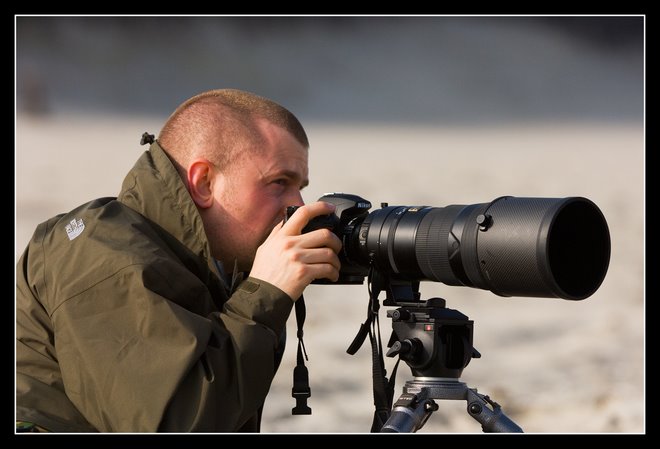For reasons of space and running costs, I have never had reason to purchase a colour photo printer for home use. Although having my own printer would give me a lot more flexibility in to what I printed and when, I feel the cost per print is not much different to various online services.
So over time I have tried out a number of online photo services in the Netherlands, but have now finally found one company that, after a number of positive experiences, am going to stick with.
The company, ProFotoNet, a division of FotoSystems in Gouda, has a very simple to use website. It is possible to either download some software (for Windows) or use their online tool (for Mac users) to upload the pictures to their server.
Previously, Mac users were a bit limited to the browsers they could use to upload their pictures, but with the latest version of the online software I have successfully uploaded with both Mozilla variants (Flock) and Safari.
The quality of the images is stunning - they print everything on Kodak Endura paper, and I choose the Endura Metallica finish, which has a layer of silver in the paper to give certain colours a metallic look when held to the light. One of the reasons that the colours are so good, and can accurately represent the image as it is on the screen, is that ProFotoNet provides icc calibration profiles, to which the images can be converted before they are uploaded. But also without these profiles, providing the images are uploaded in either AdobeRGB or sRGB, they will do the conversion for you.
The best thing about the service is the price - a 10x15cm print is only 0,32€, a 20x30 print on Endura Metallic is 2,99€, and a 30x45cm print comes in at 7,50€. Admittedly this is a bit more expensive than somewhere like the Hema, but this is a pro service, and delivers pro results.
A couple of other things worth mentioning - firstly the speed: recently I placed an order at 10pm on Sunday evening, and received the order Tuesday morning by 10am. This is normal for ProFotoNet, I think they mention on their website that if images are uploaded by 3pm, they will normally be shipped out the same day. Also the payment is very easy - the prints are made on credit, and an invoice is sent along with he prints, with the request to make payment within 14 days.
As I said, I have used a number of services in the Netherlands, but this one by far gives superior quality at reasonable prices......
Thursday 16 August 2007
Sunday 5 August 2007
Bird Photography in Scotland and Northumberland
It's been a couple of weeks now since I came back from a camping trip to Scotland and the North of England. The aim behind the trip was to photograph the puffins on the islands along the east coast before they all flew away again for the summer. We had decided to camp primarily as a cost saving exercise, but we hadn't expected the weather to be so incredibly poor as it was.
Campsites along the route were fairly easy to find, but this probably had something to do with the frequent deluges that were making the ground almost uncampable. We started off camping near St Andrews, since the trip we had initially planned to Bass Rock was rained off. A short distance from St Andrews is the port of Anstruther, from where the pleasure cruiser May Princess starts her 8km trip to the island.
Again, due to the poor weather, two of our three planned trips were cancelled, but the third trip provided us with good enough weather to get a couple of good shots. It seems that the puffins are relatively 'tame', and don't seem to be frightened by the boat loads of tourists that are landing at regular intervals, but it is still necessary to keep a distance from them and show them respect. As for most of the remainder of the trip, the Nikon 200-400mm F/4G VR lens was invaluable here, and, when used together with my Gitzo 1348 and Markins M10/Wimberley Sidekick head was adequately supported to give me sharp images.
There are a number of spots on the island where it is possible to get a good position to shoot the birds, but I found keeping away from the crowds helped in getting better shots.
Our next trip was a couple of days later to Bass Rock. This is a trip organised for photographers by the Scottish Seabird Centre, and although rather pricey at around 80 pounds per person does give some very close up views of around 100000 pairs of Northern Gannets that inhabit this otherwise deserted island.
Landing on the island really depends on good weather and the right tides, as the 'dock' is merely a few iron rungs connected to the rock. It is a good idea to rationalise the amount of equipment taken onto the island, as everything needs to be carried to the top of the rock (and Beach Rollys are not welcome here....)
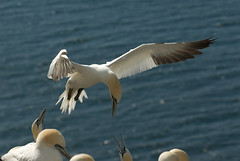
It is not necessary to have a really long telephoto on Bass Rock, as many good shots (especially flight shots) can be obtained with lenses such as the Nikon 70-200mm F/2.8G VR lens, as shown in the shot above. One thing to watch out for though is 'messages from above' as the birds don't seem to be toilet trained..... your equipment and clothing _will_ get covered in white spots however hard you try to avoid it......
The final destination for our group was the Farne and Staple Islands, back over the English border. Both of these islands belong to the National Trust, and it is worth noting that regardless of which tour operator sails you to the island, you will still need to pay a landing fee of around 4.50 pounds to enter each of the islands. Worth considering joining the National Trust if you are staying a couple of days, as this will pay for itself in the long run.
We camped just outside Seahouses, and used Billy Shiels MBE ferries to get us to and from the islands. There is a photographers trip which takes you to Staple Island in the morning, and then onto Inner Farne in the afternoon for around 25 pounds, and this is worth doing if you want to visit both islands. Note that there are no facilities on Staple, and only a basic toilet on Inner Farne, so any food to be consumed needs to be carried over from the main land.
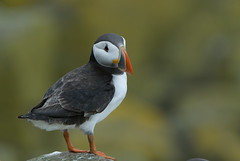
Again, the 200-400mm comes in useful on both of these islands, but nevertheless it is possible to get close to the puffins, especially on Inner Farne where the pathway runs inbetween the puffins' burrows.
In addition to the puffins, Inner Farne is also home to a flock of arctic terns. Note that the terns will attack people as they disembark from the boat and attempt to walk up onto the island. This is because they are nesting either side of the pathway, and wish to protect their young. The peck from the tern can draw blood, so it is a good idea to wear a hat or carry an umbrella (or, as we did, carry your tripod above your head)
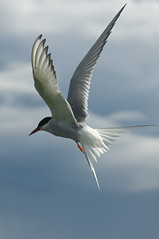
The three locations mentioned above definitely give the photographer a number of good opportunities for photographing puffins, terns, guillemots, and shags. With the exception of seasickness tablets and a good pair of walking shoes, there is nothing stopping anyone from taking images such as the ones displayed here.
Campsites along the route were fairly easy to find, but this probably had something to do with the frequent deluges that were making the ground almost uncampable. We started off camping near St Andrews, since the trip we had initially planned to Bass Rock was rained off. A short distance from St Andrews is the port of Anstruther, from where the pleasure cruiser May Princess starts her 8km trip to the island.
Again, due to the poor weather, two of our three planned trips were cancelled, but the third trip provided us with good enough weather to get a couple of good shots. It seems that the puffins are relatively 'tame', and don't seem to be frightened by the boat loads of tourists that are landing at regular intervals, but it is still necessary to keep a distance from them and show them respect. As for most of the remainder of the trip, the Nikon 200-400mm F/4G VR lens was invaluable here, and, when used together with my Gitzo 1348 and Markins M10/Wimberley Sidekick head was adequately supported to give me sharp images.
There are a number of spots on the island where it is possible to get a good position to shoot the birds, but I found keeping away from the crowds helped in getting better shots.
Our next trip was a couple of days later to Bass Rock. This is a trip organised for photographers by the Scottish Seabird Centre, and although rather pricey at around 80 pounds per person does give some very close up views of around 100000 pairs of Northern Gannets that inhabit this otherwise deserted island.
Landing on the island really depends on good weather and the right tides, as the 'dock' is merely a few iron rungs connected to the rock. It is a good idea to rationalise the amount of equipment taken onto the island, as everything needs to be carried to the top of the rock (and Beach Rollys are not welcome here....)

It is not necessary to have a really long telephoto on Bass Rock, as many good shots (especially flight shots) can be obtained with lenses such as the Nikon 70-200mm F/2.8G VR lens, as shown in the shot above. One thing to watch out for though is 'messages from above' as the birds don't seem to be toilet trained..... your equipment and clothing _will_ get covered in white spots however hard you try to avoid it......
The final destination for our group was the Farne and Staple Islands, back over the English border. Both of these islands belong to the National Trust, and it is worth noting that regardless of which tour operator sails you to the island, you will still need to pay a landing fee of around 4.50 pounds to enter each of the islands. Worth considering joining the National Trust if you are staying a couple of days, as this will pay for itself in the long run.
We camped just outside Seahouses, and used Billy Shiels MBE ferries to get us to and from the islands. There is a photographers trip which takes you to Staple Island in the morning, and then onto Inner Farne in the afternoon for around 25 pounds, and this is worth doing if you want to visit both islands. Note that there are no facilities on Staple, and only a basic toilet on Inner Farne, so any food to be consumed needs to be carried over from the main land.

Again, the 200-400mm comes in useful on both of these islands, but nevertheless it is possible to get close to the puffins, especially on Inner Farne where the pathway runs inbetween the puffins' burrows.
In addition to the puffins, Inner Farne is also home to a flock of arctic terns. Note that the terns will attack people as they disembark from the boat and attempt to walk up onto the island. This is because they are nesting either side of the pathway, and wish to protect their young. The peck from the tern can draw blood, so it is a good idea to wear a hat or carry an umbrella (or, as we did, carry your tripod above your head)

The three locations mentioned above definitely give the photographer a number of good opportunities for photographing puffins, terns, guillemots, and shags. With the exception of seasickness tablets and a good pair of walking shoes, there is nothing stopping anyone from taking images such as the ones displayed here.
Subscribe to:
Posts (Atom)
